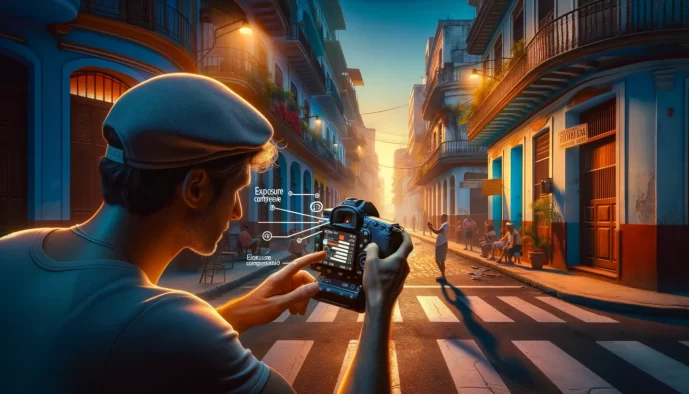Mastering Exposure Comp
Unlock the secrets to perfect photos with our guide to mastering exposure compensation.

Understanding Exposure Compensation
What is Exposure Compensation?
Exposure compensation is a camera setting that allows the photographer to adjust the exposure deemed ‘correct’ by the camera’s light meter, tailoring the brightness of the final image to their preference.
How Exposure Compensation Works in a Camera
In essence, it’s a way to bias the camera’s automatic exposure settings. Cameras typically measure light through a metering system and propose settings to achieve a balanced exposure. By using the exposure compensation feature, photographers can override the suggested settings by making the image brighter (+ values) or darker (- values).
The Exposure Triangle
Understanding the exposure triangle is crucial. It’s the foundation of not just exposure compensation, but all things photography.
Shutter Speed
Shutter speed measures the time the camera’s shutter is open, allowing light to hit the sensor. It affects both brightness and motion blur in images.
Aperture
Aperture refers to the size of the lens opening that light passes through. It influences both the exposure and depth of field, the latter dictating how much of the image is in sharp focus.
ISO
ISO is the camera sensor’s sensitivity to light. A higher ISO allows for shooting in lower light but can introduce unwanted grain, or noise, into the image.
When to Use Exposure Compensation
Overcoming Challenging Lighting Conditions
Use exposure compensation when the camera struggles with high contrast or backlit scenes. It allows you to adjust for shadows that are too dark or highlights that are overly bright.
Achieving Creative Effects
It’s also a tool for creativity. Want a silhouette or a high-key portrait? Exposure compensation is your friend.
How to Set Exposure Compensation
Using Exposure Compensation on Different Camera Modes
The feature is available in modes like Aperture Priority (A or Av), Shutter Priority (S or Tv), and Program (P). In manual mode (M), you manually adjust the exposure settings, effectively serving as your own exposure compensation.
Tips for Dialing in the Right Amount
Start with small adjustments, like 1/3 or 1/2 stops, and review your results. Consider the histogram as a more accurate representation than the camera’s LCD for judging exposure.
Exposure Compensation in Post-Processing
Adjusting Exposure in Editing Software
With tools like Lightroom or Photoshop, exposure can be fine-tuned in post. Sliders for exposure, highlights, shadows, whites, and blacks offer granular control.
Limitations of Post-Processing Compensation
Beware: post-processing has its limits, especially with extreme corrections. Underexposure can cause noise, and overexposure can lead to unrecoverable details in highlights.
Common Mistakes and Misconceptions
Overcompensating Exposure
A heavy hand can lead to loss of detail. Remember, subtlety is key; you can’t recover what’s blown out or shrouded in shadow.
Relying Solely on the Camera Meter
The camera meter isn’t infallible—it’s a guide, not gospel. Understanding scenes that typically confuse it is part of mastering exposure.
Practicing with Exposure Compensation
Real-World Scenarios for Practice
Experiment in diverse lighting, from the golden hour to overcast days. Analyze how different settings affect your images.
Learning from Trial and Error
Photography is an art, not a science. Embrace mistakes—they’re milestones on the journey to mastery.
And remember, while exposure compensation may seem like a mundane feature, it can be the difference between a good photo and a great one. If your camera’s auto-exposure were a politician, think of exposure compensation as your vote – a small but significant way to sway the outcome.